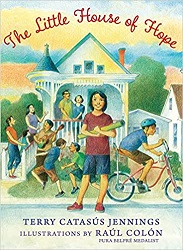by Terry Catasús Jennings
illustrations by Raúl Colón
Neal Porter Books (Holiday House), 2022. 32 pages.
Review written September 30, 2022, from a library book
Starred Review
This inspiring book made me proud to be an American, as well as blown away by a family’s joyful hospitality.
The author bases the story of Esperanza, a girl from Cuba, on her own story of her family coming from Cuba in 1961. Here’s how the book begins:
It was a little house. Una casita.
When Esperanza and Manolo and Mami and Papi
came to the United States from Cuba,
they looked and looked
for a place where they could live
that didn’t cost too much money.And then they found it.
It was small.
It smelled like old, wet socks.
It had rickety, tattered furniture
from a church basement.But even though they were far from home,
the family was together.
They were safe.
They were happy in la casita.
As the story goes on, we see each parent working two jobs and the children making their own breakfasts, helping with chores, and helping fix up la casita. They all work hard and begin learning English. They eat food in la casita that reminds them of Cuba.
The pictures are happy and hopeful. Since Esperanza’s name in English is “Hope,” she makes a collage with her name in both languages, and “Hope” represents what they’ve found in their new home.
And they spread that hope to others! Mami’s sister Conchita joins them, with her baby. She takes care of other people’s children during the day in la casita, and Esperanza gets to tend the baby.
Then they make room in the garage for a family who’ve made a tough trip from Mexico while they’re getting settled.
Even though there wasn’t much room,
everyone was happy in la casita.
As the book continues, we see the family happily sharing their space. Papi gets a job as an accountant, like he had back in Cuba, and Mami teaches high school Spanish. More people come through on their way to getting homes of their own.
The pictures in this book make it especially wonderful — on many spreads we see large, happy groups of people, enjoying one another.
And for everyone who comes through la casita and then goes on to their own place, Esperanza sends them on their way with a collage, which we see in the illustrations. The collage features “Esperanza” and “Hope,” and “Hope” is done in the colors of the American flag.
It wasn’t until my second time through the book that I noticed the Author’s Note at the front, which is more for the adult reader than for kids:
This book was written in anger, but with pride. Anger at a realtor who told me he never rented to Hispanics because they lived four families to a house and always destroyed the properties where they lived. In 1961, when my family first came from Cuba to the United States, we lived in una casita. Three families lived there, twelve of us during the week and fourteen on weekends when my uncle’s two sons came to stay with him. We came to the United States to regain our freedom, and in the case of my father, to avoid being jailed again. We landed with $50 for our family of four. In time we all became gainfully employed, each family finding a home of its own. And we all became citizens. From anger, I hope this book brings healing. It is dedicated with unwavering gratitude to the country that took us in, and to all immigrants who come to the United States in search of hope.
The lovely thing is that the picture book part of this book completely communicates that gratitude and hope. I didn’t know any anger was involved until I read the note — and what an effective answer this book is to that anger! She shows a family helping others out with love and joy, and no deprivation whatsoever, but only that overwhelming gratitude and hope.
Find this review on Sonderbooks at: www.sonderbooks.com/Picture_Books/little_house_of_hope.html
Disclosure: I am an Amazon Affiliate, and will earn a small percentage if you order a book on Amazon after clicking through from my site.
Disclaimer: I am a professional librarian, but the views expressed are solely my own, and in no way represent the official views of my employer or of any committee or group of which I am part.
What did you think of this book?
